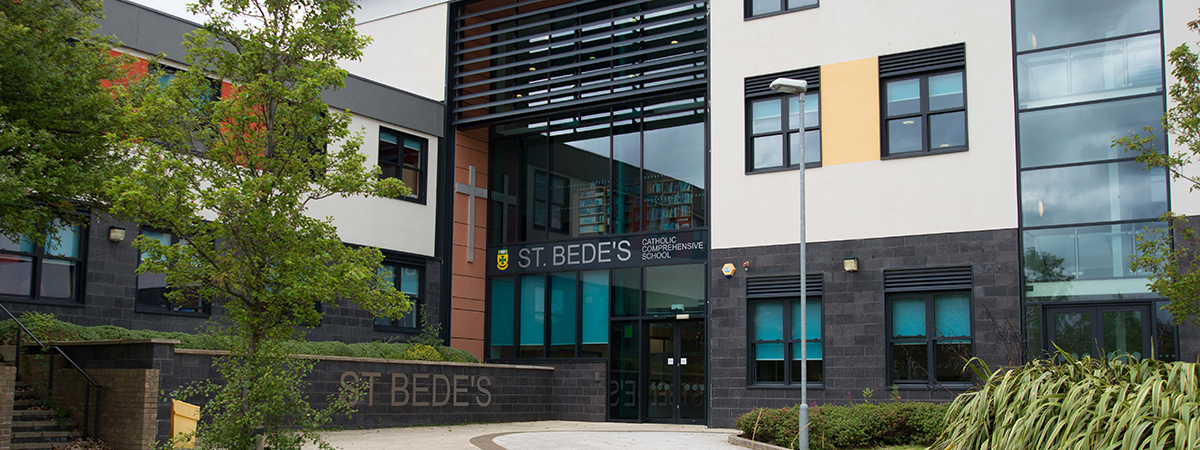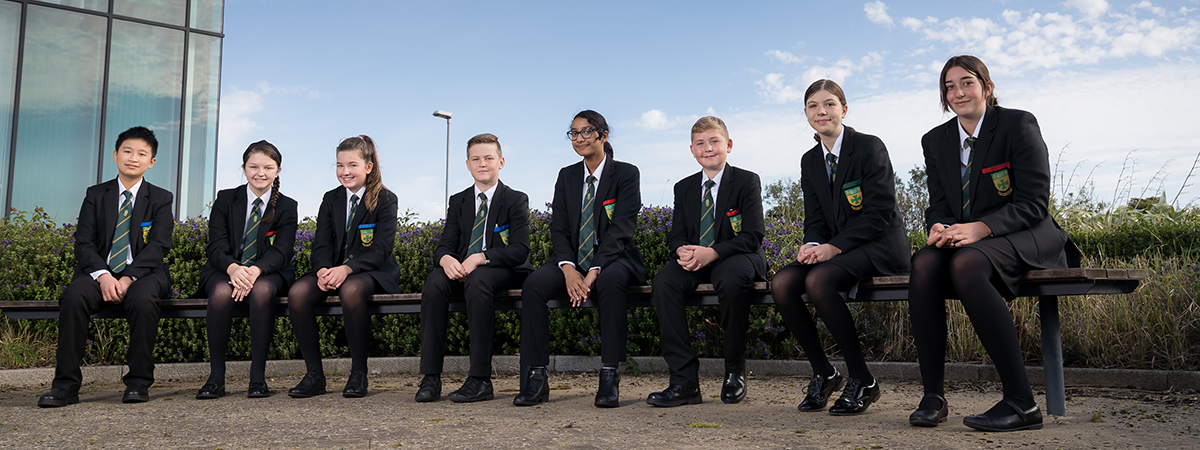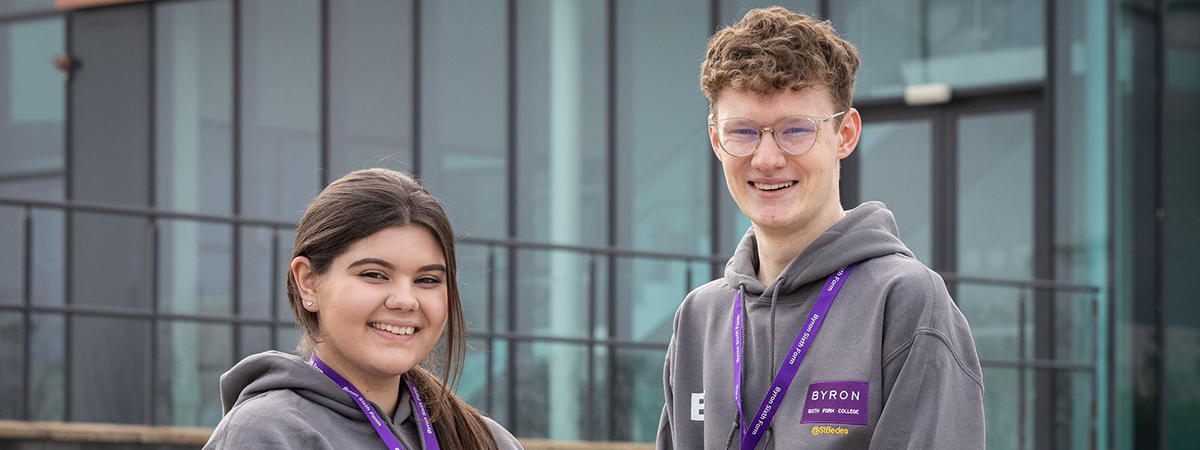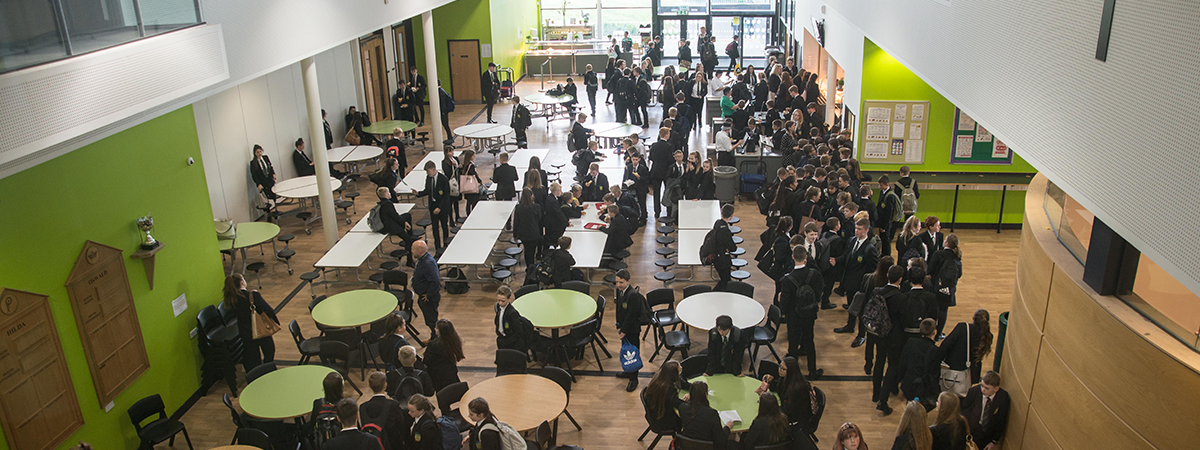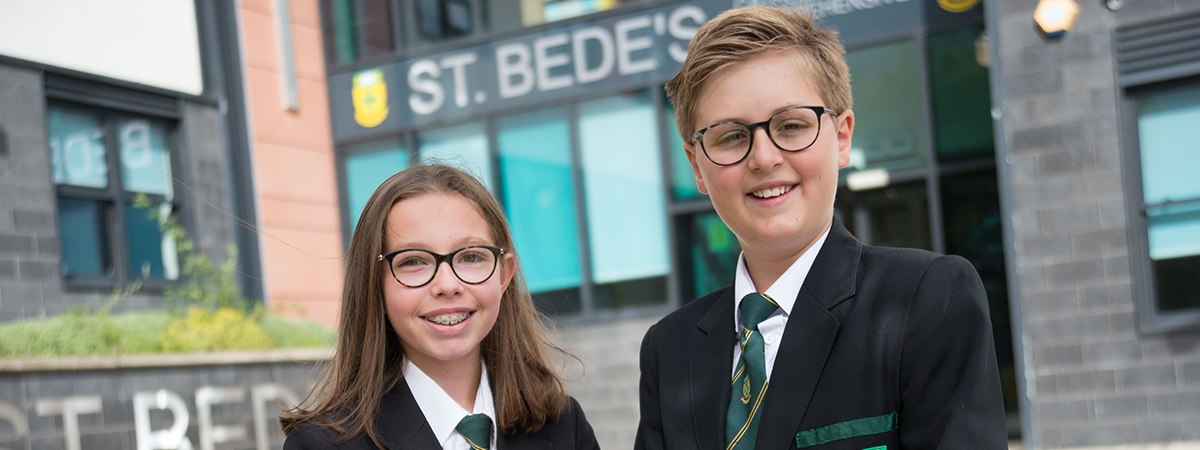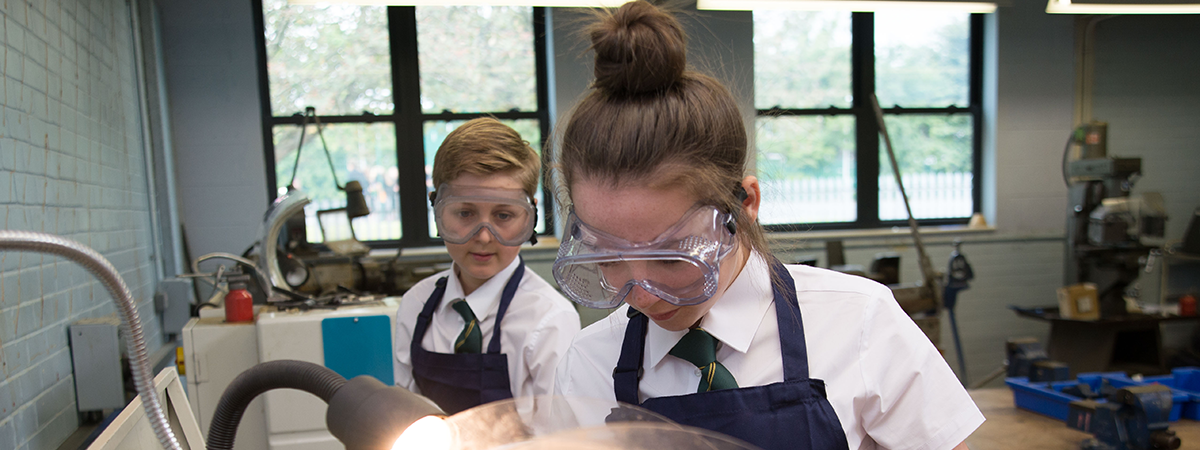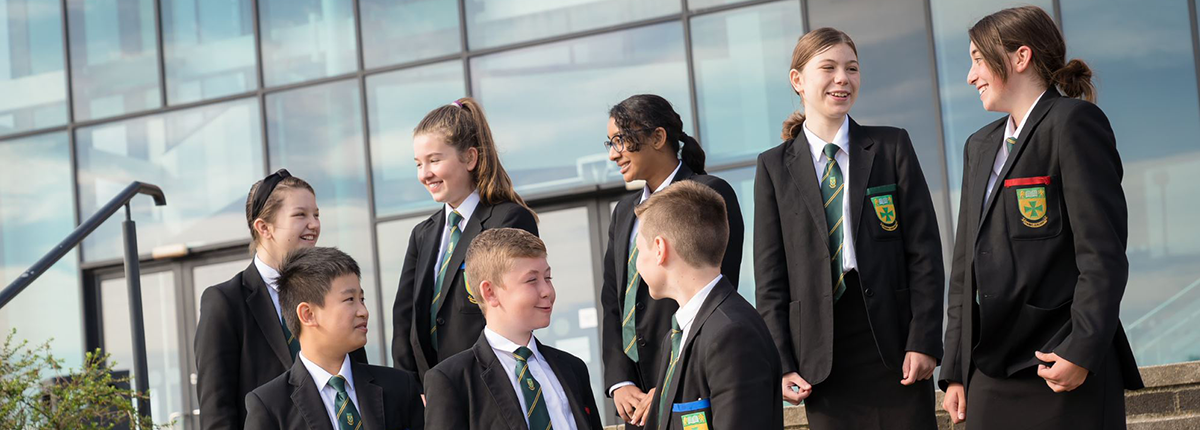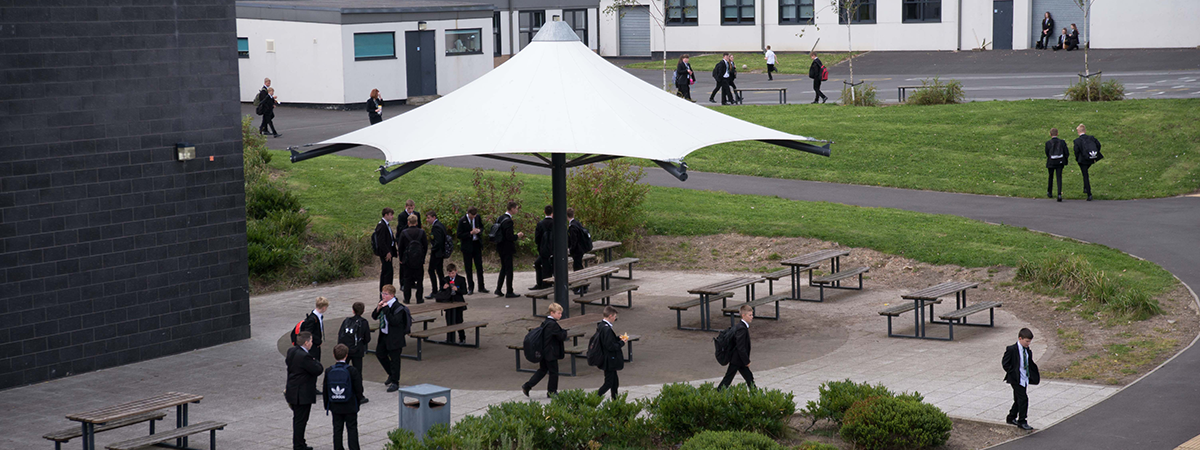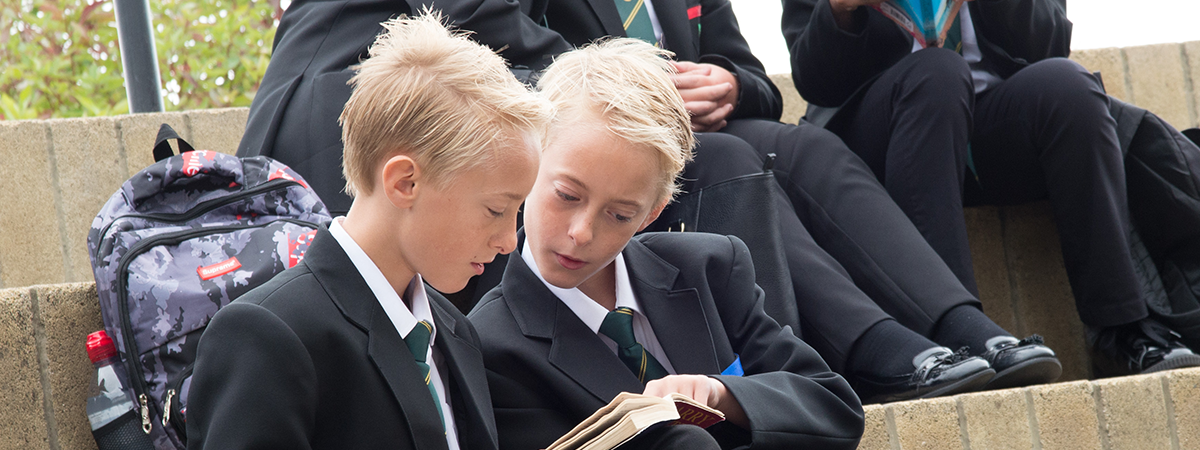Pupil premium strategy statement – St Bede’s Catholic School and Byron Sixth Form College
This statement details our school’s use of pupil premium (and recovery premium) funding to help improve the attainment of our disadvantaged pupils.
It outlines our pupil premium strategy, how we intend to spend the funding in this academic year and the outcomes for disadvantaged pupils last academic year. Costs are unusually high this academic year due to the school having to operate over two sites (RAAC). Additional spending has been needed to ensure the same provision is available on both sites to support our PP students.
School overview
| Detail | Data |
|---|---|
| Number of pupils in school | 965 (2022-23) |
| 848 (2023-24) | |
| In 2023-24 the number of students eligible for deprivation PP = 289 | |
| Proportion (%) of pupil premium eligible pupils | 25.8% (2022-23) |
| 34.1% (2023-24) | |
| Academic year/years that our current pupil premium strategy plan covers (3 year plans are recommended) | 2022/2023 – 2024/2025 |
| Date this statement was published | 12/6/2023 |
| Date on which it will be reviewed | Dec-24 |
| Statement authorised by | Frances Cessford – Headteacher |
| Pupil premium lead | Catherine Dugdale – Assistant Headteacher |
| Governor / Trustee lead | Tony McCourt |
Funding overview
| Detail | Amount |
|---|---|
| Pupil premium funding allocation this academic year | £ 241,325 (2022-23) |
| £ 299, 115 (2023-24) | |
| Recovery premium funding allocation this academic year | £ 31,755 (2022-23) |
| £ 80, 755 (2023-24) | |
| Pupil premium (and recovery premium*) funding carried forward from previous years (enter £0 if not applicable) | £0 |
| *Recovery premium received in academic year 2021 to 2022 can be carried forward to academic year 2022 to 2023. Recovery premium received in academic year 2022 to 2023 cannot be carried forward to 2023 to 2024. | |
| Total budget for this academic year | £ 273,080 (2022-23) |
| If your school is an academy in a trust that pools this funding, state the amount available to your school this academic year | £ 379, 870 (2023-24) |
Part A: Pupil premium strategy plan
Statement of intent
| “With resources and a strong determination to improve the life chances of all disadvantaged young people, schools have shown that progress can be made” Sir John Dunford St. Bede’s is a Catholic learning community in which all pupils, irrespective of their background or the challenges they face, are provided with the opportunity to flourish as a whole and complete person in a way that is rooted firmly in the values of the Gospel. Our aim, in partnership with respective parents and carers, is to support pupils in their formation: spiritual and social; intellectual and emotional; aesthetic and physical through the provision of a broad, balanced and aspirational curriculum, a rigorous, vibrant curriculum which responds to needs, and at its heart recognises justice, liberty, peace and human freedom, whilst fostering intellectual curiosity and academic achievement. The focus of our pupil premium strategy is to support disadvantaged pupils to achieve this goal, including progress for those who are already high attainers. We consider the challenges faced by vulnerable pupils, such as those who have a social worker and are young carers. The activities and routines outlined in this statement are intended to support their needs, regardless of whether they are disadvantaged or not. We truly believe that every individual is capable of excellence and we encourage each individual to work hard, fulfilling their potential to pursue their next steps in life, whether it be their choice of university, high-quality career or apprenticeship. Based on educational research we are certain that maximising learning through great teaching is the most important tool we have in ensuring the excellent progress of all pupils, including those from disadvantaged backgrounds. It is our intention that the outcome of our high quality, first wave teaching is that the attainment of non-disadvantaged pupils will be sustained whilst closing the disadvantaged attainment gap. Our approach in responding to individual needs is centred around assessment. Within the academy accurate assessment strategies enable an informed and systematic judgement to be made about a pupil’s knowledge, understanding, skills and attitude. Using this accurate assessment of pupil progress, we are able to implement the actions below swiftly and efficiently to ensure disadvantaged pupils are appropriately supported and challenged. In order to provide high quality, individually targeted support we engage with external providers recommended by the DfE and NTP providers. We strive as a school to support all pupils to make excellent progress through robust and systematic approaches to numeracy, literacy, recovery curriculum and extracurricular activities. We believe enriching education has intrinsic benefits. All children, including those from disadvantaged backgrounds, deserve a well-rounded, culturally rich, education and as a result of these experiences they attain higher. |
Challenges
This details the key challenges to achievement that we have identified among our disadvantaged pupils.
| Challenge number | Detail of challenge |
|---|---|
| 1 | Low levels of literacy and numeracy which impedes their confidence and access to deep understanding across the curriculum. |
| In 2021-22 on entry, 62% (45/73) Year 7 pupils are below expected reading age (11 years) following assessments September 2022 using Renaissance Accelerated Reader. | |
| 2 | Attendance is an issue for some disadvantaged pupils. |
| Our attendance data over the last 3 years indicates that: | |
| Attendance among disadvantaged pupils has been between 2.04% – 4.69% lower than for non-disadvantaged pupils. (gap). | |
| PA (less than 90% attendance) | |
| Over the last three years | |
| 61 / 113 of disadvantaged pupils have been ‘persistently absent’ compared to 54 / 114 of their peers during that period. Our assessments and observations indicate that absenteeism is negatively impacting disadvantaged pupils’ progress | |
| 48.6% of all PA are PP students (2021-22) | |
| 3 | Many of our PP pupils are socially, culturally, economically and knowledge deprived. Lack of aspiration and poor engagement of pupils and parents in school life particularly affects outcomes for disadvantaged pupils and attendance of disadvantaged pupils. |
| According to IDSR November 2022 | |
| The school location deprivation indicator was in quintile 5 (most deprived) of all schools. (lowest 20%) | |
| The pupil base is in quintile 5 (most deprived) of all schools in terms of deprivation. (lowest 20%) | |
| According to IDSR November 2023 the school continues to have well above national average for pupil base deprivation. | |
| 4 | Some pupils face significant challenges in their lives and have social, emotional and mental health needs that prevent them from learning. |
| Following the pandemic, teacher referrals for support markedly increased. In 2021/2022 academic year 55% of all students accessing school counselling were disadvantaged. During the first term of 2022/2023 53% of students accessing school counselling are disadvantaged and 50% of students referred to Piece of mind are also disadvantaged. | |
| For the academic year 2023/24 47% students who are accessing the school counselling service are disadvantaged. School continues to see an increase in the number of referrals for mental health support within school. | |
| In addition, 15 pupils (13 of whom are disadvantaged) currently receiving small group interventions via academic and pastoral mentoring. | |
| 5 | Our observations suggest many lower attaining disadvantaged pupils lack metacognitive / self-regulation strategies when faced with challenging tasks, notably in their monitoring and evaluation of their answers. This is indicated across the curriculum. |
| 6 | Pupil feedback informs us that at times of transition in education can bring anxiety and uncertainty. This impacts upon decision making. We will strive to educate and inform pupils at each transition point (KS2-KS3, KS4-KS5, KS5 and beyond) to enabled them to make informed choices about their future. |
Intended outcomes
This explains the outcomes we are aiming for by the end of our current strategy plan, and how we will measure whether they have been achieved.
| Intended outcome | Success criteria |
|---|---|
| Improve the progress 8/Attainment 8 score of disadvantaged pupils across the curriculum, ensuring pupils make or exceed expected levels of progress from starting points; particular focus on Languages, Maths and Humanities within EBacc element. | Closing the gap of PP and non PP: |
| See data tables at end of document. | |
| In summary: | |
| 2021-22 (P8 Gap = -0.06) | |
| 2022-23 (p8 Gap = -0.49) | |
| The P8 gap between PP and non PP widened between 2021-22 and 2022-23 | |
| Outcomes 2022 English/maths catch up (2021-22) | |
| 9-7 PP 11.1% non PP 14.3% | |
| 9-5 PP 40.7% non PP 55.1% | |
| 9-4 PP 63% non PP 77.6% | |
| English and maths progress needed | |
| Improved reading comprehension for all, particularly disadvantage pupils; focus on developing fluent reading, freeing pupil focus (cognitive resource) on word recognition and therefore improving comprehension of the text. | Reading comprehension tests will demonstrate improved comprehension skills among disadvantaged pupils and a smaller disparity between the scores of disadvantaged pupils and their non-disadvantaged peers. |
| Teachers will also have recognised this improvement through engagement in lessons, scholarly reading, daily reading, extended writing and book scrutiny. | |
| Reading Plus implemented with identified pupils with a reading age below 9years 2 months on entry – expected increase of + 6 months each year. | |
| Improve teaching some aspects of literacy, by developing pupils’ knowledge and understanding of the relationship between written symbols and sounds, particularly disadvantaged pupils. The aim is to systematically teach pupils the relationship between these sounds and the written spelling patterns, or graphemes, which represent them. Phonics emphasises the skills of decoding new words by sounding them out and combining or ‘blending’ the sound-spelling patterns. | Synthetic phonics training with staff via Sounds Write completed and embedded across the school. |
| Improved understanding of phonics, fast pace reading, word cards, dictated sounds and word sentences and how to develop this with pupils. | |
| Assessment sheets in reading books indicate pupil level understanding. | |
| Pupils read for pleasure -pupils survey. | |
| All pupils make + 6 months progress each year. | |
| Improve language enrichment for disadvantage pupils, increasing vocabulary and improving oracy and written skills/language. | Training to be undertaken by all staff to understand communication and language in greater depth, signposting up-to-date research, knowing how to identify different types of communication delay, and learning about dialogic teaching (encouraging pupils to learn by questioning and discussion) across the curriculum. |
| Improved metacognitive and self-regulatory skills among disadvantaged pupils across all subjects. | Teacher reports and class observations suggest disadvantaged pupils are more able to monitor and regulate their own learning. This finding is supported by homework completion rates across all classes and subjects. |
| Improve mastery of learning and acquisition of knowledge to ensure all learners know and remember more; particularly disadvantaged pupils in Spanish, Art, Biology, BTEC Sports and English Literature | Professional training in place and embedded for all staff. |
| 2021-2022 outcomes for PP Subject SPI: | Learners demonstrate mastery on unit tests, typically 80%, before moving on to new material. |
| Art -0.53 | All Pupils who do not achieve mastery are provided with extra support through a range of teaching strategies such as more intensive teaching, tutoring, peer-assisted learning, small group discussions, or additional homework |
| Biology -0.53 | |
| BTEC Sport -0.53 | |
| English Literature -0.39 | |
| Spanish -0.81 | |
| 2022-2023 outcomes for PP Subject SPI: | |
| Art -0.22 | |
| Biology -1.34 | |
| BTEC Sport -1.69 | |
| English Literature -0.59 | |
| Spanish -0.45 | |
| To achieve and sustain improved attendance for all pupils, particularly our disadvantaged pupils. | Sustained high attendance from 2025/2026 demonstrated by: |
| The overall absence rate for all pupils being no more than 3%, and the attendance gap between disadvantaged pupils and their non-disadvantaged peers being reduced by 2%. | |
| Develop and sustain improved resilience and aspiration among disadvantaged pupils, improving pupil social and emotional wellbeing. | Sustained high levels of wellbeing from 2025/26 demonstrated by: |
| Qualitative data from pupil voice, pupil and parent surveys and teacher observations. | |
| A significant increase in participation in enrichment activities, FAITH award, Duke of Edinburgh, university and STEM visits, volunteering and impact projects in the local community particularly among disadvantaged pupils. | |
| Significant decrease in referral to Mental Health Support Services. | |
Activity in this academic year
This details how we intend to spend our pupil premium (and recovery premium) funding this academic year to address the challenges listed above.
Teaching (for example, CPD, recruitment and retention)
Budgeted cost: £378,420.68
| Activity | Evidence that supports this approach | Challenge number(s) addressed |
|---|---|---|
| Behaviour Policy: A robust and consistent approach to behavioural expectations within the school which allows all pupils to thrive in positive learning environments. Reflecting on the consquences of their actions when things go wrong. | EEF – 3+ Months. A consistent behaviour policy supports classroom management, reducing the number of permanent or fixed term exclusions which disadvantaged pupils are more likely to receive. | 2,3,4,6 |
| Increase Pastoral Team with 3 Assistant Heads of House to support pupil wellbeing and behaviour. | ||
| Class charts | ||
| Teacher training is focussed on ensuring quality first teaching through the Great Teaching Toolkit. Teachers reflect on the key elements of excellent teaching and the science behind learning. | EEF Attainment Gap Report 2018 – | 1,5,6 |
| “Ensuring every teacher is supported in | ||
| Synthetic phonics training with staff via Sounds Write. | delivering high-quality teaching is essential to achieving the best outcomes for all pupils, particularly the most disadvantaged among them. It is crucial; therefore, that schools | |
| focus all their resources on proven ways of improving teaching.” | ||
| Sixteen staff Sounds Write trained. | ||
| 2x English, maths, RE, 2xgeog, 2xSLT, senco and ass senco, 2xTA, librarian, history, DT, Spanish | ||
| Purchase of Sounds-Write specific books which are used for intervention | ||
| Consistent, high quality active retrieval homework will support pupil’s knowledge and understanding. Homework clubs with support staff allow pupils time and space to complete this work in a conducive environment. | EEF 5+ months over a year. High quality homework and the opportunity to complete this work within school supports disadvantaged pupils who may have difficulty accessing quiet work spaces and/or technology | 1,5,6 |
| Purchase of revision guides for all subjects for students in Y10-13 | ||
| Modelling develops strategies for planning, monitoring and evaluating pupil’s own learning. | EEF – Metacognition 7+ months progress over a year when developing cognitive processes as part of the school’s curriculum and in subject specific lessons | 1,5,6 |
| These focus pupils on the self-regulated learning of cognition. Pupils are able to consider the mental process involved in knowing, understanding, and learning. | ||
| Visualizers; RE, English, maths, geography, science | ||
| Highly targeted, curriculum specific feed-back enables pupils to refocus their actions to achieve their goal. Feedback enables pupils to understand and self regulate their own improvements and progress. | EEF – Feedback 5+ months Clear and actionable feedback allows pupils to understand their specific strengths and areas for improvement. | 1,5,6 |
| All lessons within the school focus on active retrieval. These activities take account of the prior knowledge that pupils bring to lessons and to help them to build upon this understanding. Additionally, anticipating common misconceptions, and using diagnostic assessment to uncover them, is an important way to support pupils. | (Karpicke & Aue, 2015, p.318) ‘to be able to re-trieve, use, and apply knowledge in the long term, it is highly effective to practice retrieving, using, and applying knowledge during learning’ | 1,5,6 |
| Extending the school day (STEP afterschool). | EEF – 2+ months. Disadvantaged pupils may benefit from additional school time when engagement and attendance are secured. | 1,5,6 |
| Focused on year 11 students, allowing teachers to review core content and allow pupils to develop a deeper understanding of the taught curriculum. | ||
| Focus PP YR11 | ||
| 2022-23 – RAAC has impacted on the schools ability to deliver STEP. School are looking into the possibility of a late bus from Usworth to allow STEP to be delivered at the Usworth Campus | ||
| 2021-22 National Tutoring Programme provides highly targeted intervention for individual pupils in Y7 focusing on identified gaps in English, Maths and Yr 11 Science – 15 hours per subject after school | ||
| Offered to all PP students only 30 taken the opportunity) | ||
| Teaching assistants to be deployed into lessons to support acquisition of knowledge for SEND disadvantaged pupils. This work will be planned in collaboration with the classroom. | EEF 3-4 months progress over a year when used in one to one or small group settings. Explicit connections need to be made between learning from everyday classroom teaching to structured interventions. | 1 |
Targeted academic support (for example, tutoring, one-to-one support, structured interventions)
Budgeted cost: £228,689.25
| Activity | Evidence that supports this approach | Challenge number(s) addressed |
|---|---|---|
| Pupils are taught strategies in small groups to improve their reading comprehension. Focussing on decoding words, understanding language structures or developing vocabulary. | EEF Small group tuition has an average impact of +4 months’ additional progress over the course of a year. | 1,6 |
| Use of Reading Plus intelligent adaptive software to support. | Small group tuition is most likely to be effective if it is targeted at pupils’ specific needs. Diagnostic assessment can be used to assess the best way to target support. | |
| Pupils will be given the opportunity to read out loud in front of peers every day to develop their oracy skills. With small group interventions for pupils who need support in this area. | EEF 5+ Months over the course of a year. Oral language interventions with frequent sessions (3 times a week or more) over a sustained period appear to be most successful. Some pupils from lower socio-economic backgrounds are behind their advantaged counter parts. | 1,3 |
| Oracy taught explicitly, children are given enough time for talk and to express themselves. Staff are also conscious of the need to model language and conversation, so children learn to recognise language structure as well as vocabulary – quality assurance data. | Oxford Language Report and national case study 2021. | |
| Student support from OB | ||
| Vocabulary slides, including etymology, are used in each lesson, not just to display new words, but to actively integrate the teaching of vocabulary into lessons. | 1,5 | |
| Phonics interventions, supporting pupils in small groups to develop their literacy skills through the development of pupils’ knowledge and understanding of the relationship. | EEF 5+ Months over a year when taught explicitly and systematically to support children in making connections between sounds and written word. Some disadvantaged pupils may not have developed phonological awareness at the same rate as others. | 1,3,5 |
| Sounds Write Platform purchased and identified staff trained. Subject specialists available across the School. | Oxford Language Report and national case study 2021. | |
| Numeracy intervention sessions each week to develop core numeracy skills. | Evidence on mathematics from the Teaching and Learning Toolkit alongside the findings from recent EEF projects suggest that interventions should include; explicit and systematic instruction, clear support for whole class instruction and must motivate pupils. | 1,3,5,6 |
| 2022-23 Newly appointed second in maths position | ||
| Individualised instruction allowing pupils to focus on their specific learning gaps and progress at an individual level. Identified Yr7 and 10 and 11 pupils will access 15-hour blocks for English, Maths and Science with a regular impact review. | EEF 4+ months of additional progress. Disadvantaged pupils are more likely to have a poor attendance rate and therefore will have knowledge gaps. Individualised instruction can allow pupils to consolidate learning and practise new skills. | 1,5 |
| National Tutoring Program (2021-22) | ||
| Attendance officer supports individual attendance gaps, liaising with families and tracking progress. | “An evidence informed approach to improving attendance” by Durrington Research School outlines the importance of robust attendance data tracking and monitoring systems in schools, to address attendance issues. | 2 |
| Increased capacity through appointment of pupil support officer – attendance focus. | ||
| Trust attendance officer appointed to support team. | ||
| School attendance officer and Family support officer (YS/MM) to support PP families improving student attendance | ||
| Blue Support – intervention targeted at students with the lowest progress to date following prelims (focus PP boys). The support consists of weekly one to one academic mentoring to set and monitor personal targets alongside daily check-ins. | EEF : The impact of mentoring varies but, on average, it is likely to have a small positive impact on attainment. | 1,2,3,4,5,6 |
| Positive effects on attainment tend not to be sustained once the mentoring stops, so care must be taken to ensure that benefits are not lost. | ||
| Academic mentoring for 6th Form students consisting of action planning and target setting focusing on increasing VA | EEF : The impact of mentoring varies but, on average, it is likely to have a small positive impact on attainment. | 1,2,4,5,6 |
| Positive effects on attainment tend not to be sustained once the mentoring stops, so care must be taken to ensure that benefits are not lost. | ||
| KS4/5 Ambitions programme | ||
| 1:1 support for sixth form students from MO (Oxnet) | ||
| 1:1 support for sixth form students from RS | ||
| Specific targeted intervention with female pp pupils, consist of one-one and small group sessions focusing on confidence, target setting and tools to succeed | EEF : The impact of mentoring varies but, on average, it is likely to have a small positive impact on attainment. | 1,3,4,5,6 |
| Positive effects on attainment tend not to be sustained once the mentoring stops, so care must be taken to ensure that benefits are not lost. | ||
| One to one support and small group activities for PP students identified as being in risk of NEET. Support and sessions provided by DWP | 1,3,4,5,6 |
Wider strategies (for example, related to attendance, behaviour, wellbeing)
Budgeted cost: £67,413.84
| Activity | Evidence that supports this approach | Challenge number(s) addressed |
|---|---|---|
| Reading Canon – 3 books per year group (7-13) | EEF 7+ months progress over the course of a year – Successful reading comprehension allows pupils to develop their reading capabilities in an environment which allows effective but not over-whelming challenge. | 1,3 |
| Pupils read age appropriate texts in form groups, read aloud, developing reading comprehension, | Oxford Language Report and national case study 2021. | |
| inferring meaning from context linked to 9 protected characteristics, summarising key points and developing questioning skills. | ||
| . | ||
| Developing oral language skills through spoken language and verbal interaction in the classroom. | EEF – 5+ Months progress over a year. Pupils from lower socioeconomic backgrounds are more likely to be behind in language and speech skills which affect future learning. | 1,3,6 |
| This occurs through targeted reading aloud and book discussion linked to 9 protected characteristics – 25-minute slots five times per week. | Oracy interventions allow pupils to catch up with peers. | |
| Oxford Language Report and national case study 2021. | ||
| Pupils with identified reading age, via accelerated reader, of below 9 Years 2 months also access support with trained staff via Reading Plus – 4x per week for 30 minutes. | ||
| Embedding a school wide approach to enhanced numeracy development – ALL staff as leaders of numeracy. | Evidence on mathematics from the Teaching and Learning Toolkit alongside the findings from recent EEF projects suggest the importance of modelling positive attitudes towards numeracy whole school and the importance of developing pupil’s ability to reflect on and articulate reasoning strategies. | 1,3,5,6 |
| 2022-23 Newly appointed second in maths to provide whole school training. Introduction of the trust calculation policy | ||
| Regular opportunities for parental engagement allow leaders to involve parents in the learning process focussing on main transition points in KS2/3, KS4/5 and KS5/University. These sessions cover; assessment; revision strategies; LMI and careers; purpose of homework; reading; literacy and numeracy strategies. | EEF – 2+ Months. Disadvantaged pupils are less likely to participate in formal and informal educational activities in holidays. Parental engagement sessions can support parents to assist their children’s learning and self-regulation at home. | 2,3,5,6 |
| Reading Canon books for parents purchased alongside online virtual library to support parent reading club. | ||
| Development of pupil metacognition through timetabled revision days which provide pupils a repertoire of strategies to choose from and the skills to select the most suitable strategy for their independent revision. Suitable revision guide/material purchased for all disadvantaged pupils. | EEF – Metacognition strategies offer an additional seven months’ progress over the course of a year when explicitly taught these strategies. Explicit teaching of metacognitive and self-regulatory strategies encourages pupils to practise and use these skills more frequently in the future. | 1,2,3,4,5,6 |
| A school wide approach to developing a culture of intrinsic motivation through metacognition with a particular focus on self-regulating motivation. | EEF – Impact for disadvantaged pupils who are potentially +7 months when pupils have developed this motivation and it becomes independent and habitual. | 3,4,5 |
| Aspirational extra curricula opportunities in: science, STEM, languages and humanities. The activities include: science club, local industry opportunities, Art, Sport/PE, cooking, music ,language visits, educational excursion | Children from the wealthiest backgrounds are 3 times more likely to take up music classes out of school hours than children from the poorest backgrounds. There is also a 20% participation gap in sport, a new report by the Social Mobility Commission reveals (Friday 19 July). “Our report shows that a young person may miss out on some of the most valuable experiences in life – a chance to bond with others, aspire to learn more, and gain the soft skills so important to employers – simply because of their social background and where they grew up. It is time to level the playing field” | 2,3,4,5,6 |
| Purchase of scientific calculators for PP students | ||
| Enrichment activities which develop metacognition and leadership skills such as FAITH, Duke of Edinburgh and John Paul II Award, Business Magnets | EEF – Life Skills and Enrichment: “At the EEF, we think enriching education has intrinsic benefits (sometimes referred to as “arts for arts’ sake”). We think all children, including those from disadvantaged backgrounds, deserve a well-rounded, culturally rich, educate | 2,3,4,5,6 |
| However, many go beyond this and argue that enrichment approaches can directly improve pupils’ attainment” | ||
| Educational trips subsidised for PP students | ||
| A careers curriculum which offers breadth and depth to pupils throughout their time in the academy through university visits, work experience, information, advice and guidance. | EEF – Careers Education states: “Careers education can be crucial in developing the knowledge, confidence and skills young people need to make well informed, relevant choices and plans for their future. This is especially true of pupils from poorer backgrounds, who are less likely to have family or friends with the insight and expertise to offer advice. High quality careers education can help them progress smoothly into further learning and work.” | 2,3,4,5,6 |
| 1:1 careers support and guidance for students in Y11-13 | ||
| Ambition programme to promote Higher Education opportunities to pupils yrs 7-13. | “Young people from a disadvantaged background are more likely to move to higher education after Key Stage 5, compared to those from a more advantaged background” | 1,2,3,4,5,6 |
| Ambition Scholars to identify and support students to gain access to more competitive universities and career paths. | ||
| Going Further 2021, Sutton Trust | ||
| AHOH role to support with improving attendance. AHOH to work with families to support with PP persistent absence. | EEF – Poor school attendance is a significant problem in the UK and many other countries across the world. In 2019/20, it was reported as 4.9% overall, with special schools showing a higher rate equal to 10.5% and persistent absence at 13.1% in England (gov.uk 2020). Research has found that poor attendance at school is linked to poor academic attainment across all stages (Balfanz & Byrnes, 2012; London et al., 2016) as well as anti-social characteristics, delinquent activity and negative behavioural outcomes (Gottfried, 2014; Baker, Sigmon, & Nugent, 2001). However, evidence suggests that small improvements in attendance can lead to meaningful impacts for these outcomes. | 2,3,4,5 |
| The Hub | EEF – Social and emotional learning approaches have a positive impact, on average, of 4 months additional progress in academic outcomes over he course of an academic year. | 2,3,4,5 |
| Development of the hub to support PP SEND students who need additional support in school to access learning. The hub is used to support PP students re-engaging with learning following a period of absence from school. | ||
| School counselling service to support PP students mental health and wellbeing. | EEF – Social and emotional learning approaches have a positive impact, on average, of 4 months additional progress in academic outcomes over he course of an academic year. | 2,3,4,5 |
Total budgeted cost: £674,523.77
Part B: Review of the previous academic year
Outcomes for disadvantaged pupils
| Outline outcomes for disadvantaged pupils in the 2021 to 2022 academic year and explain how their performance has been assessed. | |||
|---|---|---|---|
| KS4 Outcomes | |||
| PP Headline Figures KS4 | |||
| 2019-20 | |||
| P8 | A8 | Av. A8 Grade | |
| Non PP | 0.52 | 55.9 | 5.59 |
| PP | 0.14000000000000001 | 42.7 | 4.2699999999999996 |
| PP Girls | 0.22 | 42.28 | 4.2300000000000004 |
| PP Boys | 0.02 | 43.33 | 4.33 |
| 2020-21 | |||
| P8 | A8 | Av. A8 Grade | |
| Non PP | 0.76 | 58.89 | 5.89 |
| PP | 0.36 | 43.58 | 4.3600000000000003 |
| PP Girls | 0.5 | 45.75 | 4.58 |
| PP Boys | 0.24 | 41.71 | 4.17 |
| 2021-22 | |||
| P8 | A8 | Av. A8 Grade | |
| Non PP | 0.21 | 54.53 | 5.45 |
| PP | 0.15 | 45.99 | 4.5999999999999996 |
| PP Girls | -0.44 | 41.1 | 4.1100000000000003 |
| PP Boys | 0.66 | 50.54 | 5.05 |
| 2022-23 | |||
| P8 | A8 | Av. A8 Grade | |
| Non PP | 0.1 | 48.01 | 4.8 |
| PP | -0.39 | 35.369999999999997 | 3.54 |
| PP Girls | -0.24 | 35.590000000000003 | 3.56 |
| PP Boys | -0.55000000000000004 | 35.15 | 3.52 |
| Ebacc: | |||
| Uptake in 2020 16% of Ebacc students were PP; 2021 26%; 2022 30%; | |||
| Target uptake for 2024 40% of Ebacc pupils will be PP | |||
| KS5 Outcomes | |||
| PP Headline Figures KS5 | |||
| 2019-20 | |||
| L3 Average Grade | L3 overall Average Points Per Pupil | L3 VA | |
| PP | C+ | 95 | 0 |
| Non PP | B= | 120.89 | 0.83 |
| 2020-21 | |||
| L3 Average Grade | L3 overall Average Points Per Pupil | L3 VA | |
| PP | N/A | N/A | N/A |
| Non PP | B= | 122.61 | 0.62 |
| 2021-22 | |||
| L3 Average Grade | L3 overall Average Points Per Pupil | L3 VA | |
| PP | C= | 83.75 | 0.06 |
| Non PP | B- | 111.31 | -0.08 |
| 2022-23 | |||
| L3 Average Grade | L3 overall Average Points Per Pupil | L3 VA | |
| PP | C- | 82.86 | -0.42 |
| Non PP | B- | 106.52 | -0.38 |
Externally provided programmes
Please include the names of any non-DfE programmes that you used your pupil premium (or recovery premium) to fund in the previous academic year.
| Programme | Provider |
| Adaptive Literacy and Intervention. | Reading Plus |
| Careers guidance | Careerwave |
| Duke of Edinburgh Award | St Bede’s |
| Music Tuition | Durham Music Service |
| Work related support | Durham Works |
Service pupil premium funding (optional)
| For schools that receive this funding, you may wish to provide the following information: How our service pupil premium allocation was spent last academic year |
| The impact of that spending on service pupil premium eligible pupils |
Pupil Premium Strategy Statement 2022-2023

